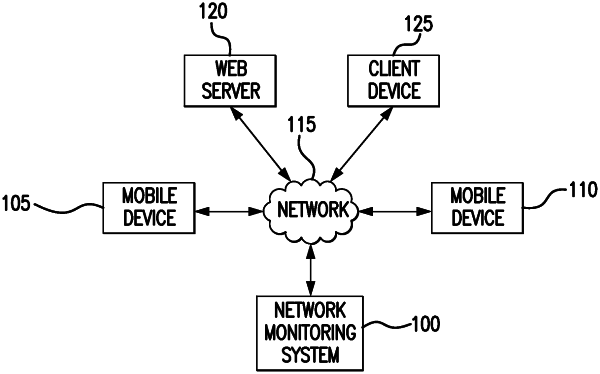| CPC H04L 41/0631 (2013.01) [H04L 41/5009 (2013.01); H04L 43/091 (2022.05); H04L 69/40 (2013.01)] | 4 Claims |

|
1. A network monitoring system for detecting service failures by mobile devices in a telecommunications network, comprising:
a network monitoring probe coupled to a telecommunications network configured to capture data packets from the telecommunications network and combine related data packets into generated session records, wherein each session record includes multiple segments;
a network monitoring device coupled to the network monitoring probe configured to analyze and generate alarms regarding a segment of a generated session record while the session record is active, the network monitoring device including:
a processor; and
a memory coupled to the processor, the memory configured to store program instructions executable by the processor to cause the network monitoring system to:
store user preconfigured Service Level Objectives (SLOs) specific to a plurality of network services in one or more databases;
identify a plurality of services provided by a network operator based upon analysis of a segment of a session record while the session record is active, wherein to identify a plurality of services provided by a network operator, the program instructions are further executable by the processor to cause the network monitoring system to classify the plurality of services based on Internet Protocol (IP) addresses, Access Point Names (APN), Quality of Service (QoS) or combination thereof;
assign a unique global identifier to each identified service in a data repository wherein the unique global identifier is stored in association with: 1) a service identifier name; 2) classification type description; and 3) classification attribute for an identified service;
calculate a plurality of Key Performance Indicators (KPIs) associated with the identified plurality of services on a per service basis, wherein each KPI value is stored together with the associated assigned unique global identifier in the data repository, wherein to calculate a plurality of KPIs associated with the identified plurality of services, the program instructions are further executable by the processor to cause the network monitoring system to identify a set of KPIs that indicate quality of the identified plurality of services;
characterize one or more service levels of individual services provided by the network operator based on the stored plurality of KPIs by correlating the preconfigured SLOs with historical data and with the calculated KPI values and comparing the calculated KPI values with target values to render off-target KPIs;
create Call Detail Records (CDRs) by categorizing messages in the captured data packets, via a call trace application;
analyze the captured data to categorize between high-value captured network traffic and low- value network traffic present in the captured data based upon a set of heuristics;
identify a root cause of service level failures for one or more of the plurality of services, in response to determining that at least one of the characterized service levels does not meet predefined service level objectives for the one or more of the plurality of services wherein the service level failures comprise one or more failures to meet predefined SLOs stored in the one or more databases such that service levels are characterized by correlating SLOs with collected historical data and with the calculated KPI values;
generate an alarm message including the one or more of the plurality of services based on the identified root cause and the calculated plurality of KPIs; and
including a priority level to the alarm message, the priority level calculated based on the kind of technical equipment, impact of the service level failure, and impact on other services provided by the network.
|